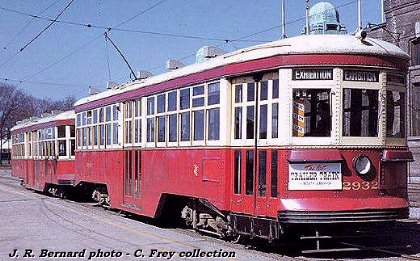D
Duck
Guest
Somewhere a decision has to be made - is it better to buy 7 module to start, or go with 10-module platforms and buy 5 module trains that you can later pair up.
It boils down to ridership projection and vehicle cost. Then there is the headway.Somewhere a decision has to be made - is it better to buy 7 module to start, or go with 10-module platforms and buy 5 module trains that you can later pair up.




You make it sound like they're two different products. They're not.
That said, you are most certainly right that the tooling and supply chain will already exist in North America. While it wouldn't stop them from building them in Europe, it is, if nothing else, a check mark in the box for constructing them at Thunder Bay.
Dan
Toronto, Ont.
I defer to your knowledge on this because you know better than anyone in this forum, but my understanding was BBD Europe basically went "here" and sent NA all the files on F2. Them Flexity Freedom was developed and modified from that.




But what about the body frames? FLEXITY 2 has inset windows and 2 doors per side per "suspended" module, while FLEXITY Freedom has full-length glass panels, and only 1 door per side per suspended module... so doesn't that mean the actual frame itself underneath must be totally different?
When I watch the video showing Blackpool's F2 production, the frame looks completely different from the type of frames that are going into Outlook (and presumably Freedom) - ie, the Thunder-Bay produced models. They are more a traditional weldment fabrication.
...although now I am even more confused because I see that Blackpool's F2 has one door per suspended module, muddling this even further... I must have remembered it wrong. Drum I am not sure why you brought up the Siemens ULF tram? That is a really odd one - single wheels between each module, and each of them is essentially driven by a servo so it can properly articulate around curves.
I guess we can for sure say though that F2 and Freedom both use the same fixed-bogie, every-other module concept for articulation and it's a shared platform architecture.
You make it sound like they're two different products. They're not.
Dan
Toronto, Ont.
TTC also doesn't like an unique fleet that becomes power-hog in the quiet hours. They just waste more power while carrying less people. They'll end up like the majority of the artics being keep at garages on weekends.
Don't quote me on this one. I don't think you can take the streetcars apart like that. They'll have to be designed to be either 3 or 7 segments. Physical appearance shows that the middle section have to stay cause that's where the pantograph is located. The 2nd section is the accessibility ramp. So if TTC wants a longer car, they'll have to redesign them like the 4-car TRs.I don't suppose that the tail end of the existing order could be swapped out to produce, say, 25 7-segment cars and 25 3-segment cars?
- Paul
I saw pans in various locations on 5 & 7 section trams and the above photos show some of that.Don't quote me on this one. I don't think you can take the streetcars apart like that. They'll have to be designed to be either 3 or 7 segments. Physical appearance shows that the middle section have to stay cause that's where the pantograph is located. The 2nd section is the accessibility ramp. So if TTC wants a longer car, they'll have to redesign them like the 4-car TRs.




